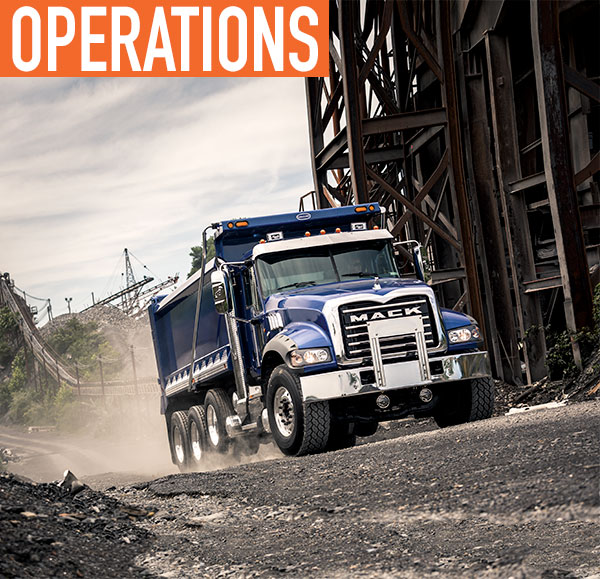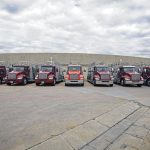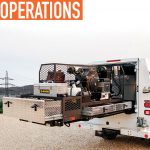Vocational vehicles—those used for a specific application such as logging, heavy haul, or refuse collection—represent around 20 percent of sales of all Class 4 to 8 commercial vehicles in the US. However, given the complexity of the individual markets they serve, they are often overlooked in traditional market studies.
Interact Analysis, a global market research provider, recently released a new medium and heavy commercial vehicle forecast with a special focus on vocational vehicles. Alastair Hayfield, research director with Interact Analysis, shares his views on the US market, outlining the current state of the industry and what’s in store for the coming years.
US VOCATIONAL VEHICLE MARKET
Sales of vocational vehicles in the US totaled more than 93,000 in 2017. This is forecast to grow by 9 percent in 2018 to nearly 102,000 vehicles. Dump trucks (44 percent) and utility vehicles (20 percent) represent the bulk of sales.
CONSTRUCTION MARKET
The US construction market remains relatively strong. Residential and non-residential construction levels are still some way below the previous market peak in real terms. In terms of outlook, this means sentiment is still positive and, as a result, we expect to see significant investment in both expanding and updating dump truck fleets used for transporting materials/aggregates as demand increases. From 2020 onward, the market is forecast to soften as the current investment cycle finishes. The only uncertainty here would be if the Trump administration-proposed infrastructure investment plan were to gain momentum and pass. This would act as an additional positive catalyst on the construction market.
Oshkosh reported in its second quarter 2018 results a 22.2 percent increase for its construction vehicle segment versus the previous year, including both concrete mixers and refuse vehicles. Terex Corporation—which manufactures aerial work platforms, cranes, and material processing equipment—reported strong demand for aerial work platforms in North America along with other equipment. This is a positive leading indicator that construction remains strong.
FIRE AND RESCUE MARKET
Sales of vehicles for fire and rescue applications account for 3 percent of vocational vehicle sales. In recent years market conditions have been tough—investment in new vehicles is often done at a local level, and funding has been restricted since the global recession. However, more recently there has been a return to optimism within the market.
Oshkosh—the parent company of Pierce Manufacturing—reported improved results in its 2018 second quarter for its fire and emergency business. It expects “flat to slight growth in 2018” based on a drive to replace aging fleets and better-than-expected municipal tax receipts that can be used to fund the purchase of new vehicles. REV Group—the parent company of E-One, KME, and Ferrara—also reported positive growth of 16.1 percent in its 2018 first quarter, driven in part by increasing unit volumes.
UTILITY
Utility vehicles range in size and application. Some are relatively small and can be customized to carry small tools or equipment. Others are large vehicles with a boom arm used for reaching structures at height. The utility market is closely tied to activity in the construction market but also industrial capital expenditure. With a strong domestic construction market and some positive momentum in capital expenditure driven by the Trump administration tax reforms, investment in new and replacement utility vehicles is likely to be strong.
Strong growth for commercial vehicle sales is projected in 2018 and forecasted to continue a pattern of growth in the coming years. The growth is fueled by favorable economic growth, demand in the vocational market, and fleet investments in low-emission vehicles.
ELECTRIFICATION
The vocational truck market is also examining how electrification can be used to reduce emissions. Given the heavy-duty cycle and need for additional hydraulics/power for lifts, cranes, etc. for some vocations, electrification isn’t always practical. However, applications where electrification makes sense for vocational vehicles include urban operations—refuse collection, concrete mixers—and light-duty cycles such as street cleaners or certain utility vehicles. Some recent examples:
- Mack Trucks, a division of Volvo, introduced an electric refuse truck in 2018.
- Peterbilt, a division of Paccar, introduced an electric refuse truck in 2017.
- BYD introduced an electric refuse truck in 2017.
- Shaanxi Automotive and EDI developed a PHEV cement mixer in 2017.
- CIFA, a division of Zoomlion, introduced its PHEV Energya mixer truck in 2013.
BYD delivered an electric refuse truck to Palo Alto, and a Motiv Power Systems-powered refuse truck is set to be used in Sacramento. XL Hybrids—a rapidly growing provider of fleet electrification products—announced that Verizon would take 234 of its hybrid electric vans in 2017 to support its utility operations. XL announced a new deal in 2018 with Puget Sound Energy (PSE) to supply 40 electrified utility vehicles. Whilst in some instances the deployments are small tests, the XL Hybrid deals show that major fleets are prepared to invest substantially in new, less-polluting vehicles.
AUTOMATION AND AUTONOMY
Another hot topic in the commercial vehicle market is automation and autonomy—essentially the replacement of certain driving tasks or driving itself through a combination of sensors, processors, and intelligent software.
These technologies lend themselves to long distance freight transport. Tasks that require extended concentration or repetition can be automated to reduce fatigue and the risk of accidents; or driving methods such as platooning can be achieved that lower fuel consumption. However, for vocational vehicles, often they don’t travel long distances (making platooning less relevant), sometimes they operate in off-highway environments without access to high-definition mapping data (making autonomy harder to achieve), and in most cases, the driver or passengers are required to perform a task at the destination or along the route (meaning that, although a driver may not be required, space for passengers is required).
Interact Analysis is of the opinion that automation and autonomy will be slower to penetrate the vocational vehicle market than the freight market. As it does, it may actually benefit drivers and vehicle operators, freeing them up to give more attention to the tasks that await them.
FOR MORE INFORMATION:
Interact Analysis is an international provider of market research for the Intelligent Automation sector. Founded in 2017, Interact Analysis has offices in the US, China, and the UK. Find out more, visit www.interactanalysis.com.
MODERN WORKTRUCK SOLUTIONS: JULY 2018 ISSUE
Did you enjoy this article?
Subscribe to the FREE Digital Edition of Modern WorkTruck Solutions magazine.
![]()





